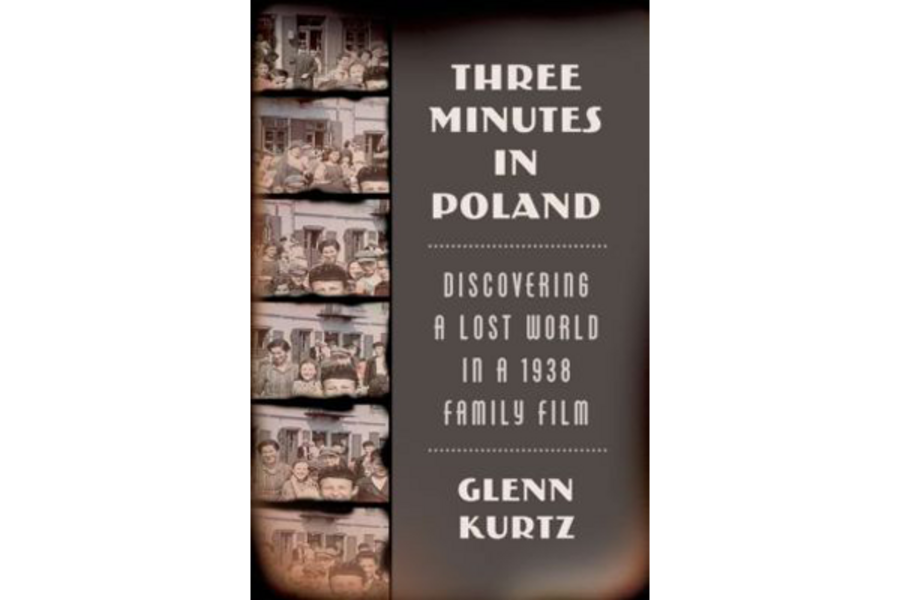'Three Minutes in Poland' gives new life to a town wiped out by the Holocaust
Loading...
How does one write of an abomination? How to serve and preserve a people and a place wiped off the face of the earth by evil? To touch its piquancy, avoid melodrama, make real its honor and dignity, its contradictions and scandals, the vital and messy humanness of the human project trooping along? It isn’t easy.
In Three Minutes in Poland, Glenn Kurtz accomplishes the act not through mourning, though melancholy is as much a part of the book’s atmosphere as oxygen is part of ours, but through revivifying those people and that place, an undertaking full of his own human miscues – for flaws are both ineluctable and providential to the process – and luminous bursts of incarnation.
Squirreled away in his parents’ home, Kurtz finds a 16-mm reel of his grandparents’ 1938 European vacation, fits and starts of their upper-middle-class Grand Tour, some of the footage in black-and-white and some in color, a real amateur production. Included in the reel is three minutes of their visit to the shtetl of Nasielsk in Poland, his grandfather’s hometown, which from the get-go is misidentified as Berezne, his grandmother’s birthplace. No, this won’t be an easy pilgrimage, but “fed by grief over my father’s death,” Kurtz is hungry to know more about the people, to realize a larger story from a snippet.
The three minutes in Nasielsk turn out to a blessing. For one, they are the only surviving film of this Polish town. And in their amateurishness, Leslie Swift, a Holocaust archivist tells Kurtz, the scenes “provide insight into the town’s social life, and they reveal individual personalities in unguarded moments, dimensions absent from newsreels and propaganda films. Moments like this endow home movies with such poignance, Leslie said, and they constitute an irreplaceable documentary resource.”
The color footage, in particular, is valuable, for color doesn’t create the temporal distance of black-and-white images. Color erases that boundary, with startling immediacy. Here are the people in the village, doing ordinary things, “they’re living their lives ... and everything is about to change in a horrible way.” Yet, if you only think about what is to come, there is the danger of losing the reality of these people, the essence that they lived lives worth knowing. That is what Kurtz is after.
It will take Kurtz four years to track down eight of the faces in the film, eight men and women out of the 100 Nasielsk Jewish survivors out of the 3,000 Jewish members of the pre-war Nasielsk community. Enormous spadework is involved, culling archives, embarking on many hit-or-miss missions, and Kurtz takes us with him. It is an important element of the enterprise, to follow the reweaving of the web from scattered fragments. As these are elderly ladies and gentlemen by now, memories will not be all they used to be. They are precious, however tangled as they may be – “I didn’t realize what happens when you start telling stories,” said Susan Weiss, one of the eight. “You lose yourself. For several days, I couldn’t find myself.” And a few of them will be gold.
Maurice “Morry” Chandler – once Moszek Tuchendlerin Nasielsk, once Zdzisław Pływacz in wartime incognito – 86 years old, is one big nugget, “the film’s Rosetta stone.” A survivor by dint of being “a tough guy, a Tom Sawyer – clever guy, a very cautious, reckless, likable guy. A very frightened, traumatized guy,” Morry is now an elder passing down stories, the oldest form of preservation, and it is from him that Kurtz learns the art of listening. “These seventy-five-year-old stories are highly polished, worn smooth from retelling. It took me a long time to learn Morry’s history well enough to ask for details not in these practiced versions ... to spark memories Morry had not known he possessed.”
Not only is Morry’s personal story a mindbender, but he holds the key to Nasielsk’s daily life, the local color that offers entrée into the town’s actuality. Here we met the town painter, Fishl the Lame, the restaurateur, the blacksmith who made the ironwork for the second-story balconies, the man who carved the tombstones, the girl who took fish oil, the town bully, the makers of sweets, the tinsmith, and the bossy housewife, their families, their homes, their streets. There is the smell of a plowed field, the bitter divisions between rival religious ideologies, the fashions of the day, the frescoes in the shul, the circus coming to town, the button factory, the grudges and fights. It is a privilege to witness Morry, looking at the film, remember he had a childhood. “Yes, there was a world. It was a real world there. I mean, people were going about their business. Kids were running, and doing all the things that kids do. And here I look at myself, and I see I was a happy face.”
There are others from Nasielsk whom Kurtz will meet, 80- and 90-year olds fashioning their town from a child’s-eye view. “Kids were throwing rocks and chasing cats and frogs,” or the Hasidic youth ruing “the terrible crime of riding a bicycle.” Kurtz is the bearer of fragmented memories, from person to person, place to place. The pieces start to coalesce, precipitating out of an isolated suspension. He forges connections, starting the weave that will put Nasielsk back on the map.






